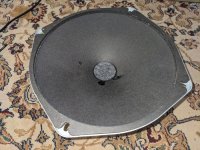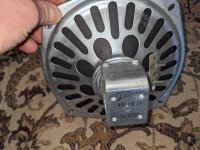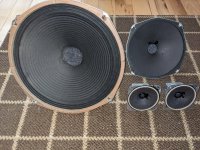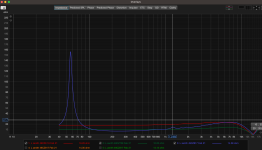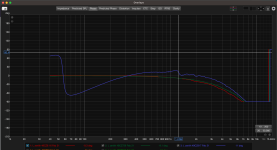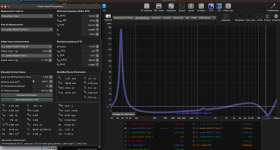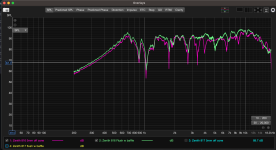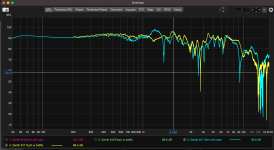Hi Gurus!
I am trying to figure out how to model the lower frequencies from the attached speaker, which is an old zenith driver.
The surround of the cone does not have the typical flexible gasket, but this
Driver seems to have a nice sound down in the 500 hz zone, though it only goes to 8khz or so.
All the modeling software that I have used so far requires Sd...but this is surely not a pistonic movement situation.
Is this a case where I am going to have to acoustically measure in the baffle to know what things look like? Or is there a rough way to estimate and get close?
Is this thing even worth playing with? I suspect there is a reason I don't see these anywhere but old systems.
I am trying to figure out how to model the lower frequencies from the attached speaker, which is an old zenith driver.
The surround of the cone does not have the typical flexible gasket, but this
Driver seems to have a nice sound down in the 500 hz zone, though it only goes to 8khz or so.
All the modeling software that I have used so far requires Sd...but this is surely not a pistonic movement situation.
Is this a case where I am going to have to acoustically measure in the baffle to know what things look like? Or is there a rough way to estimate and get close?
Is this thing even worth playing with? I suspect there is a reason I don't see these anywhere but old systems.
Attachments
Thanks @GM. I am still quite new to this, so am going to have to read this a few times to comprehend. It looks like the 416-8B is different, and much larger (~13.5" vs about 7"). So maybe not so prized, but I think it sounds "fresh"...without any real measurements...and probably a lot of hope.
This is my first real attempt at building from scratch, if you discount me messing around a lot (unsuccessfully) with a cannibalized bose acoustimass system....so I guess it is going to be my first successful build.
The driver set that I am working with comes from a scrapped Zenith cabinet that I scavenged off CL (attached), and my intent was to build a corner mono cabinet.
The little tiny tweeters only go up to 8K or so, but are 16 ohm. They were part of a "presence" channel in the original cabinet, and were angled about 30 degrees off baffle in opposing directions.
I really liked the sound of the woofer, and figure that I should try to keep this set together. but I need to figure out how low to go with the mid. and looks like the crossover is in the few hundred Hz range.
I started down the path of the decca corner horn, but am now not so sure. I am not sure about a crossover in the low hundreds with the woofer angled up and back, and then there also might be reflections to the backside of the OB.... And...the problem is I started playing with hornresp....and suddenly I ran into option overload..Would something like the Brociner w-bin approach for the bass work better here, with an open baffle for the mid tweet? The woofer models well in a TL, but not one the shape of the decca....
My plan is to make this self powered, and so bi-amping is possible, and I did by a DSP, but ideally I would just use the DSP to design and optimize the crossover strategy. My preference would be a single channel solution, and passive components, though I can't exactly say why.
Open to any and all input, and thanks for listening to my rambling.
This is my first real attempt at building from scratch, if you discount me messing around a lot (unsuccessfully) with a cannibalized bose acoustimass system....so I guess it is going to be my first successful build.
The driver set that I am working with comes from a scrapped Zenith cabinet that I scavenged off CL (attached), and my intent was to build a corner mono cabinet.
The little tiny tweeters only go up to 8K or so, but are 16 ohm. They were part of a "presence" channel in the original cabinet, and were angled about 30 degrees off baffle in opposing directions.
I really liked the sound of the woofer, and figure that I should try to keep this set together. but I need to figure out how low to go with the mid. and looks like the crossover is in the few hundred Hz range.
I started down the path of the decca corner horn, but am now not so sure. I am not sure about a crossover in the low hundreds with the woofer angled up and back, and then there also might be reflections to the backside of the OB.... And...the problem is I started playing with hornresp....and suddenly I ran into option overload..Would something like the Brociner w-bin approach for the bass work better here, with an open baffle for the mid tweet? The woofer models well in a TL, but not one the shape of the decca....
My plan is to make this self powered, and so bi-amping is possible, and I did by a DSP, but ideally I would just use the DSP to design and optimize the crossover strategy. My preference would be a single channel solution, and passive components, though I can't exactly say why.
Open to any and all input, and thanks for listening to my rambling.
Attachments
Jeff,The surround of the cone does not have the typical flexible gasket, but this
Driver seems to have a nice sound down in the 500 hz zone, though it only goes to 8khz or so.
Looks like your 7" driver has a tiny edge roll that could flex enough for mid range.
If crossed over at 1000Hz, a hardly visible 1/10th of a millimeter one way movement would result in ~113dB SPL at one meter, probably requiring a 40 watt peak. These drivers seldom were used with amps more than around 10 watts.
It's close enough to pistonic for the range it would likely be used, 400 Hz to 4kHz.All the modeling software that I have used so far requires Sd...but this is surely not a pistonic movement situation.
That's always best- it should be crossed over around the point where it's response drops by -3 to-6dB.Is this a case where I am going to have to acoustically measure in the baffle to know what things look like?
Well, you already determined it sounds OK at 500Hz, so there's a rough "playing around" estimate.Or is there a rough way to estimate and get close?
Is this thing even worth playing with? I suspect there is a reason I don't see these anywhere but old systems.
The reason you don't see these old drivers around much any more is because most people prefer smaller cabinets to produce equivalent sound levels, and power is cheap.
Art
You're welcome!Thanks @GM. I am still quite new to this, so am going to have to read this a few times to comprehend. It looks like the 416-8B is different, and much larger (~13.5" vs about 7").
I really liked the sound of the woofer, and figure that I should try to keep this set together. but I need to figure out how low to go with the mid. and looks like the crossover is in the few hundred Hz range.
I started down the path of the decca corner horn, but am now not so sure. I am not sure about a crossover in the low hundreds with the woofer angled up and back, and then there also might be reflections to the backside of the OB.... And...the problem is I started playing with hornresp....and suddenly I ran into option overload..Would something like the Brociner w-bin approach for the bass work better here, with an open baffle for the mid tweet? The woofer models well in a TL, but not one the shape of the decca....
Yes it's a comparison of a 15" wide range flex woofer Vs a so called rigid one that's not really and if it was a 7" comparison the results would be similar, though in either case they're ~ pistonic out to the VC's or dust cap's dia. frequency and 100% pistonic once larger than ~13543" SoS/pi/driver dia. = Hz.
What Art said......
Interesting; assuming a very high Qts, I figured the Decca folding and any of the early bass horns would be OK, especially the EV Baronet folding style, so what T/S specs you using?
Hi Art/GM, thanks guys for the continued input and help. I would like to very much continue to solicit your help, but it is probably best first to separate the woofer from the mid-tweet, since the woofer behaves "normally", and the mid absolutely does not appear to correspond with Art's guess based off of a bad photo. Since I can't figure out how to input photos with captions, etc, will break it into two...
Mid-Tweet: 7" Zenith 49CZ816
This one shows no resonant peak (and I cant see any meaningful flex zone at the edge).
This morning, after reading your replies, I ran a quick test with ~5g added mass. It had basically zero impact on the impedance curve.
In the attached, the green is the measurement with added mass. and this was done with my kids playing video games in the background...so pardon the excess noise...
This one shows no resonant peak (and I cant see any meaningful flex zone at the edge).
This morning, after reading your replies, I ran a quick test with ~5g added mass. It had basically zero impact on the impedance curve.
In the attached, the green is the measurement with added mass. and this was done with my kids playing video games in the background...so pardon the excess noise...
Attachments
So in a nutshell, I don't know how to predict SPL with the 7"...
I do have a microphone, but then I don't quite know how to back out from that data to extrapolate the 7" to another format. For example - it is open baffle now - but what if moved to a closed box (for example behind the baffle within the TL/horn). Is this a case of having to commit to the mid-tweet, and then seeing is the base cab deliver? In which case is there a way to avoid having to build each variant and measuring?
I do have a microphone, but then I don't quite know how to back out from that data to extrapolate the 7" to another format. For example - it is open baffle now - but what if moved to a closed box (for example behind the baffle within the TL/horn). Is this a case of having to commit to the mid-tweet, and then seeing is the base cab deliver? In which case is there a way to avoid having to build each variant and measuring?
In general, can't comment on new(er) mids, tweets, but the pioneers typically reactance annulled them (if I understand it correctly)*, so impedance is near enough max damped just as your measurement shows, making their preferred 1st order a simple/cheap XO solution on the low end and ditto when this zobel on the high end.Mid-Tweet: 7" Zenith 49CZ816
This one shows no resonant peak (and I cant see any meaningful flex zone at the edge).
*
rear chamber tuning (Fc) = (Fs*Fhm)^0.5
The box only loads the driver to its upper mass corner (Fhm) where T/S theory peters out:
Fhm = 2*Fs/Qts'
Fs: Fhm*Qts'/2
Qts': 2*Fs/Fhm
(Qts'): (Qts) + any added series resistance (Rs)
You can compare the near field response of each driver to get an idea of relative sensitivity.So in a nutshell, I don't know how to predict SPL with the 7"...
I do have a microphone, but then I don't quite know how to back out from that data to extrapolate the 7" to another format.
Interesting the 7" does not appear to have an Fs.
Linkwitz probably can give you an idea of what to expect in open baffle compared to sealed:For example - it is open baffle now - but what if moved to a closed box (for example behind the baffle within the TL/horn). Is this a case of having to commit to the mid-tweet, and then seeing is the base cab deliver? In which case is there a way to avoid having to build each variant and measuring?
https://www.linkwitzlab.com/models.htm
Thanks guys. Every time I think I have a clue, the onion gets unpeeled a bit more.
My suspicion is that I still am missing something..probably quite a bit more. But as I read Linkwitz, it seems to me that passive solutions do not apply to this system, which naively I was hoping for.
So in a nutshell, I gather from from the linkwitz that how low you go and how loud is driven by cone excursion, and I would either need a preamp circuit(s) for the low boost filtering, or a DSP. I did buy a cheap dsp card (generic amazon adau1701 2 to 4), with my original thinking that it would be easier to prototype...now it seems like this is a better permanent solution. Is a cheap DSP solution going to limit me? It certainly would make things easier. And a lot less wiring.
I appreciate much, the help. The next step for me is measurements....hopefully later today.
My suspicion is that I still am missing something..probably quite a bit more. But as I read Linkwitz, it seems to me that passive solutions do not apply to this system, which naively I was hoping for.
So in a nutshell, I gather from from the linkwitz that how low you go and how loud is driven by cone excursion, and I would either need a preamp circuit(s) for the low boost filtering, or a DSP. I did buy a cheap dsp card (generic amazon adau1701 2 to 4), with my original thinking that it would be easier to prototype...now it seems like this is a better permanent solution. Is a cheap DSP solution going to limit me? It certainly would make things easier. And a lot less wiring.
I appreciate much, the help. The next step for me is measurements....hopefully later today.
Zenith 816.
I placed both drivers in a baffle, so that at least I could start getting some measurements. After reading Linkwitz, I realized that not only is my solution going to be unique to the drivers...but also very much to the room and placement (and...a corner placement). So rightly or wrongly, I had thought it best to start in the intended room, which is fairly large, with a high sloping ceiling. I have not gotten far enough with REW to quite understand the room part of things...but was hoping that gating the microphone would manage the reflections....but...the SPL curve was definitely not as flat as I would have hoped.
There are quite a few dips of significance, and I am not sure if it is due to the measurement approach, interaction with the baffle, or something inherent with the driver itself?
The driver is currently mounted behind the baffle, and so is recessed about 3/4", with no bevel on the cutout. Measurements were taken in two locations - about 5mm from the felt "cone" deep in the throat, and a second central to the cone, but with the microphone at the mouth flush to baffle level. Green is the mouth measurement. These dips are audible during scan.
I placed both drivers in a baffle, so that at least I could start getting some measurements. After reading Linkwitz, I realized that not only is my solution going to be unique to the drivers...but also very much to the room and placement (and...a corner placement). So rightly or wrongly, I had thought it best to start in the intended room, which is fairly large, with a high sloping ceiling. I have not gotten far enough with REW to quite understand the room part of things...but was hoping that gating the microphone would manage the reflections....but...the SPL curve was definitely not as flat as I would have hoped.
There are quite a few dips of significance, and I am not sure if it is due to the measurement approach, interaction with the baffle, or something inherent with the driver itself?
The driver is currently mounted behind the baffle, and so is recessed about 3/4", with no bevel on the cutout. Measurements were taken in two locations - about 5mm from the felt "cone" deep in the throat, and a second central to the cone, but with the microphone at the mouth flush to baffle level. Green is the mouth measurement. These dips are audible during scan.
Attachments
Last edited:
Zenith 817.
By contrast, the 10" behaves more like what I expected. Though things do start to break up over 2k.
By contrast, the 10" behaves more like what I expected. Though things do start to break up over 2k.
Attachments
Last edited:
All of these measurements were done using an Aiyama a07 amplifier, which apparently has pretty poor damping at higher frequencies (or so I read on an audio forum). Could this be playing a factor in the drivers response?
Most importantly, what to do with the 816 (7") speaker. are the dips avoidable..or baked in. In which case, is there any reason to continue trying to use this thing for this application? Mainly I am building this to learn, so I am trying to avoid taking the easy route quite yet.
As for the 817. there is a bunch of junkiness between 3 and 4 k. What could be the cause of this?
Most importantly, what to do with the 816 (7") speaker. are the dips avoidable..or baked in. In which case, is there any reason to continue trying to use this thing for this application? Mainly I am building this to learn, so I am trying to avoid taking the easy route quite yet.
As for the 817. there is a bunch of junkiness between 3 and 4 k. What could be the cause of this?
@GM . Thanks. with a few words you sent me down another learning opportunity. So this is interesting in that it falls right dab into the range of the BBC dip? And, after reading a bit - the felt dust cap is apparently known to be damping..and intentionally so at times. I have a bit more reading to do here, but my first inclination is not to start messing with the dustcap.
So neglecting the dip, the phase goes all wonky right where this starts to happen. Is this something to worry about and a sign to avoid surpassing this frequency?
So neglecting the dip, the phase goes all wonky right where this starts to happen. Is this something to worry about and a sign to avoid surpassing this frequency?
Attachments
Technically, yes, but DIY speaker design is all about how it performs, so had you not measured it, would you have wanted to do something about it from a sonic POV?
Frankly, I'm glad I couldn't measure much beyond Fs, tuning with the rest of the BW based on youthful women's preferences since their hearing was much keener. Based on what all I've seen on the forums though, I'm pretty sure I'd be told to start back at square one. They all were great party speakers though since women do like to dance!
They all were great party speakers though since women do like to dance!
Frankly, I'm glad I couldn't measure much beyond Fs, tuning with the rest of the BW based on youthful women's preferences since their hearing was much keener. Based on what all I've seen on the forums though, I'm pretty sure I'd be told to start back at square one.
 They all were great party speakers though since women do like to dance!
They all were great party speakers though since women do like to dance!- Home
- Loudspeakers
- Multi-Way
- How to model this speaker - is Sd relevant
